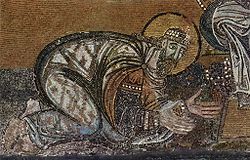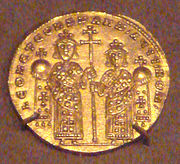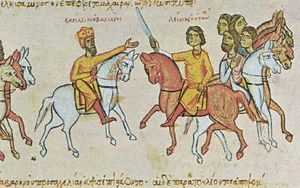Leo VI the Wise
| Leo VI | |
|---|---|
| Emperor of the Byzantine Empire | |
 |
|
| A mosaic in Hagia Sophia showing Leo VI paying homage to Christ | |
|
|
|
| Reign | 29 August 886 – 11 May 912 |
| Coronation | 869 as co-emperor |
| Predecessor | Basil I |
| Successor | Alexander |
| Spouse | Theophano Zoe Zaoutzaina Eudokia Baïana Zoe Karbonopsina |
| Issue | |
| Eudokia Anna Anna Basil Constantine VII |
|
| Full name | |
| Leo VI "the Wise" or "the Philosopher" | |
| Dynasty | Macedonian |
| Father | Michael III (probable) or Basil I |
| Mother | Eudokia Ingerina |
| Born | 19 September 866 |
| Died | 11 May 912 (aged 45) |
| Burial | Church of the Holy Apostles, Constantinople |
Leo VI, surnamed the Wise or the Philosopher (Greek: Λέων ΣΤ΄ ὁ Σοφός, Leōn VI ho Sophos, 19 September 866 – 11 May 912), was Byzantine emperor from 886 to 912. The second ruler of the Macedonian dynasty (although his parentage is unclear), he was very well-read, leading to his surname. During his reign, the renaissance of letters begun by his predecessor Basil I continued, but the Empire also saw several military defeats in the Balkans against Bulgaria and against the Arabs in Sicily and the Aegean.
Contents |
Background
Leo was born to Eudokia Ingerina, the former mistress of Emperor Michael III, and Caesar Basil.[1][2][3] In 867, Michael was assassinated by Basil, who succeeded him as Emperor Basil I. As the second eldest son of the Emperor, Leo was associated on the throne in 870 and became the direct heir on the death of his older half-brother Constantine in 879. However, he and his father hated each other and Basil almost had Leo blinded as a teenager. On August 29, 886, Basil died in a hunting accident, though he claimed on his deathbed that there was an assassination attempt in which Leo was possibly involved.
Domestic policy
One of the first actions of Leo VI after his succession was the reburial of Michael III in Constantinople, which may have contributed to the suspicion that he was Michael's son. Seeking political reconciliation, the new emperor secured the support of the officials in the capital, and surrounded himself with bureaucrats like Stylianos Zaoutzes and the eunuch Samonas. His attempts to control the great aristocratic families (e.g., the Phokadai and the Doukai) occasionally led to serious conflicts. Leo also attempted to control the church through his appointments to the patriarchate. He dismissed the Patriarch Photios of Constantinople, who had been his tutor, and replaced him with his own 19-year old brother Stephen in December 886. On Stephen's death in 893, Leo replaced him with Zaoutzes' nominee, Antony II Kaleuas, who died in 901. Leo then promoted his own imperial secretary (mystikos) Nicholas, but replaced him with his spiritual father Euthymios in 907.
The magnificent Church of Ayios Lazaros in Larnaca was built during Leo VI rule in the late 9th century. The church is one of the best examples of Byzantine architecture. Leo also completed work on the Basilica, the Greek translation and update of the law code issued by Justinian I, which had been started during the reign of Basil.
Bishop Liutprand of Cremona gives an account similar to those related about caliph Harun al-Rashid, stating that Leo would sometimes disguise himself and look for injustice or corruption. On one account, he was even captured by the city guards during one of his investigations. He wanted to know if the city patrol was doing its job appropriately. Late in the evening, he was walking alone and disguised. Though he bribed two patrols for 12 nomismata, and moved on, the third city patrol arrested him. When a terrified guardian recognized the jailed ruler in the morning, the arresting officer was rewarded for doing his duty, while the other patrols were dismissed and punished severely.
Foreign policy

Leo VI was not as successful in battle as Basil had been. In indulging his chief counselor Stylianos Zaoutzes, Leo provoked a war with Simeon I of Bulgaria in 894, but was defeated. Bribing the Magyars to attack the Bulgarians from the north, Leo scored an indirect success in 895. However, deprived of his new allies, he lost the major Battle of Boulgarophygon in 896 and had to make the required commercial concessions and to pay annual tribute.
The Emirate of Sicily took Taormina, the last Byzantine outpost on the island of Sicily, in 902. In 904 the renegade Leo of Tripolis sacked Thessalonica with his Muslim pirates (an event described in The Capture of Thessalonica by John Kaminiates). In 907 Constantinople was attacked by the Kievan Rus' under Oleg of Novgorod, who was seeking favourable trading rights with the empire. Leo paid them off, but they attacked again in 911, and a trade treaty was finally signed.

Fourth marriage dispute
Leo VI caused a major scandal with his numerous marriages which failed to produce a legitimate heir to the throne. His first wife Theophano, whom Basil had forced him to marry, died in 897, and he married Zoe Zaoutzaina, the daughter of his adviser Stylianos Zaoutzes, though she died as well in 899. Upon this marriage Leo created the title of basileopatōr ("father of the emperor") for his father-in-law.
After Zoe's death a third marriage was technically illegal, but he married again, only to have his third wife Eudokia Baïana die in 901. Instead of marrying a fourth time, which would have been an even greater sin than a third marriage (according to the Patriarch Nicholas Mystikos) Leo took as mistress, Zoe Karbonopsina. He married her only after she had given birth to a son in 905, but incurred the opposition of the patriarch. Replacing Nicholas Mystikos with Euthymios, Leo got his marriage recognized by the church, but opened up a conflict within it and allowed new grounds for papal intervention into Byzantine affairs when he sought and obtained papal consent.
Succession
The future Constantine VII was the illegitimate son born before Leo's uncanonical fourth marriage to Zoe Karbonopsina. To strengthen his son's position as heir, Leo had him crowned as co-emperor on May 15, 908, when he was only two years old. Leo VI died on May 11, 912. He was succeeded by his younger brother Alexander, who had reigned as emperor alongside his father and brother since 879.
Works
A collection of oracular poems and some short divinatory texts, at least in part based on earlier Greek sources, were attached to the emperor's name in later centuries. He is also the author, or at least sponsor, of the Tactica, a notable treatise on military operations.
He is credited with translating the relics of St. Lazarus to Constantinople in the year 890. There are several stichera (hymns) attributed to him which are chanted on Lazarus Saturday in the Eastern Orthodox Church. He also composed hymns which are sung on the Great Feast of the Exaltation of the Cross.
Notes
- ↑ (French) Adontz, Nicholas. "L'Age et l'origine de l'empereur Basil I." Byzantion, 8, 1933, pp. 475–550; 9, 1934, pp. 223–260.
- ↑ "There was some gossip recorded and passed on by the chronicles that Basil's successor, Leo VI, was actually sired by Michael III and as a consequence was not Basil's genuine son. The careful study of this gossip has shown that it has no basis in fact": Charanis, Peter (1963). The Armenians in the Byzantine Empire. Lisbon: Calouste Gulbenkian Foundation. p. 35.
- ↑ "The question as to whether Leo VI was the legitimate son of Basil I or the illegitimate son of Michael III has been frequently and hotly disputed, but it can now be taken as proved that he was the son of Basil I": Ostrogorsky, George (1969). History of the Byzantine State. New Brunswick, N.J: Rutgers University Press, p. 233, note 1.
References
- The Oxford Dictionary of Byzantium. Oxford University Press. 1991.
External links
 Media related to Leo VI at Wikimedia Commons
Media related to Leo VI at Wikimedia Commons- French translations of a Turkish-language compendium of divinatory works, including some ascribed to Leo the Sage available at http://www.ancientlibrary.com/turk-div/.
|
Leo VI the Wise
Macedonian Dynasty
Born: 19 September 866 Died: 11 May 912 |
||
| Regnal titles | ||
|---|---|---|
| Preceded by Basil I |
Byzantine Emperor 886–912 |
Succeeded by Alexander |
|
|||||||||||||||||||||||